Newark St Mary MagdaleneGlass
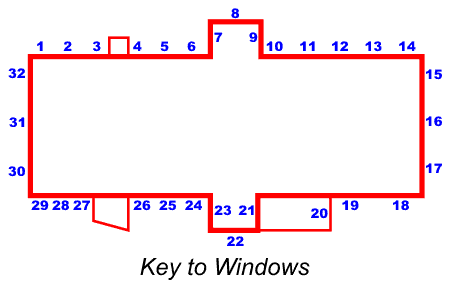
All the windows in the church date from the nineteenth and twentieth centuries,
with one exception. This is the mediaeval window in the Holy
Spirit Chapel.
North Aisle Windows
The three stained-glass windows at the west end of the north aisle have a
common theme, and are meant to be viewed together. Each depicts four Old Testament
figures, with a scene from the life of each. They are memorials to the Branston
and Taylor family, and are all the work of Burlison & Grylls of Newman
Street, London. They were installed in 1903.
 1.
Memorial Window to George Henry Branston 1.
Memorial Window to George Henry Branston
Shows representations and scenes from the life of: Abel, Enoch, Noah and Abraham.
 2.
Memorial Window to Henry Branston, JP 2.
Memorial Window to Henry Branston, JP
Henry Branston was an Alderman of the Borough, and a benefactor of the church
and the town. The window shows: Sarah, Isaac, Jacob and Joseph, again with
a scene from the life of each.
 3.
Memorial Window to John and Anna Taylor 3.
Memorial Window to John and Anna Taylor
Donated by their son, Dr Charles Richard Taylor. Once again there are four
Old Testament figures depicted, this time: Moses, Joshua, Samuel and David.
4. to 14.
These windows are all plain glass. They were installed as part of the 1850s restoration,
but were severely damaged in a freak storm in July 1903, when three thousand
eight hundred of the diamond panes had to be replaced.
East End Windows
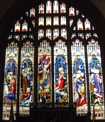 15.
St George’s Chapel Window 15.
St George’s Chapel Window
This window, by Hardman & Co of Birmingham, was installed in 1871. It
is a memorial to James Prior Lacy who was a respected surgeon in the town,
and appropriately the subject of the window is “suffering and healing”.
It shows four healing miracles in the side panels: Peter’s mother-in-law,
the woman with a haemorrhage, the centurion’s servant, and the blind
man. The two centre panels together show the agony of Christ. It forms the
backdrop of the St George’s Chapel.
 16.
Great East Window 16.
Great East Window
This window was installed in 1864 as a memorial to Prince Albert, the money
being raised by public subscription. Like the previous window, this was designed
and made by Hardman & Co of Birmingham, but has a very different effect.
There are two tiers of lights. The subject in the upper tier is the Ascension
of Christ. The lower tier contains scenes from the life of Christ, though much
of this is hidden from the body of the church by the reredos.
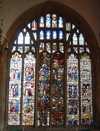 17.
Mediaeval Window in the Holy Spirit Chapel 17.
Mediaeval Window in the Holy Spirit Chapel
This window has been assembled from a large number of panels and pieces of
mediaeval stained glass. In 1846 all the mediaeval fragments of glass from
around the church were brought together and assembled haphazardly into a window.
In 1957 the window was restored and re-arranged by Miss Joan Howson of the
Department of Mediaeval Art of Oxford University.
The glass is from the fourteenth and fifteenth centuries, though the two central
lights are more in a thirteenth century style. The four centremost lights are
made up of complete panels, whereas the outer two are mainly fragments fitted
together. There are many subjects represented: Biblical scenes, legendary and
symbolic events, saints, coats of arms, etc., as well as some purely decorative
work.
The window now lights the Holy Spirit Chapel.
South Aisle Windows
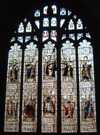 18.
Memorial Window to Canon Walker 18.
Memorial Window to Canon Walker
This is the latest window to be installed in the church. It is a memorial
to Canon James Manders Walker, who was Vicar of the church. It was installed
in 1929 and was designed by Percy Bacon of Endsleigh Gardens, London. It depicts
ten British saints. The window stands next to the Holy
Spirit Chapel, which was itself planned and partly paid for by Canon Walker.
19. and 20.
Windows of plain glass.
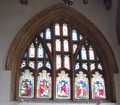 21.
Memorial Window to Dr Thompson 21.
Memorial Window to Dr Thompson
Dr William Edward Thompson was a native of Newark and much respected in the
town. This window, by Clayton and Bell of London, was installed in 1861. It
depicts five healing miracles, all from St Luke’s Gospel.
22. and 23.
Windows of plain glass.
 24.
Godfrey Memorial Window 24.
Godfrey Memorial Window
This window was placed as a memorial to Thomas Spragging Godfrey, his wife
Elizabeth, and daughter Jane Ann. It is by William Wailes of Newcastle-upon-Tyne
and was installed in 1859. It was originally intended to be placed in the Great
West Window, but was given its present location on the advice of George Gilbert
Scott. It depicts scenes from the lives of the Old Testament prophets.
 25.
Gilstrap Memorial Window 25.
Gilstrap Memorial Window
This window, by Alfred Gerente of Paris, was installed in 1869 as a memorial
to Elizabeth and Joseph Gilstrap, members of a notable Newark family of maltsters.
There are four lights, each containing three medallions on vivid blue backgrounds,
depicting scenes from the Old Testament in a thirteenth century French style.
 26.
Hodgekinson Memorial Window 26.
Hodgekinson Memorial Window
George Hodgekinson, who died in 1856 and to whose memory this window was dedicated,
was a notable Newark solicitor. The window is by William Wailes of Newcastle-upon-Tyne,
and dates from around 1859. It is of a similar style to the Godfrey
Window (also by Wailes) and depicts eight scenes from the Old Testament.
 27.
Sarah Good Memorial Window 27.
Sarah Good Memorial Window
This is a half window, the other half being blocked by the south porch. Miss
Good was a school-mistress in Newark, and the window was donated by her pupils
in 1891. It is a grisaille window by Powell and Son of Whitefriars, London,
similar to the clerestory windows which are also
by Powell.
 28.
Window donated by Becher Tidd Pratt 28.
Window donated by Becher Tidd Pratt
This window, like the Queen Victoria Window, is by CE Kempe. The figures
in the upper part of the four lights represent the evangelists. The two scenes
in the lower part of the window are of the young Christ with the doctors in
the temple, and the Adoration of the Magi.
 29.
Queen Victoria Window 29.
Queen Victoria Window
This window is also by Kempe. It was donated in memory of Queen Victoria by
women workers of the parish, and paid for with money set aside from sales of
work. It was dedicated in 1902. The pattern of the window is similar to the
previous one, and depicts four Old Testament figures (Moses, David, Isaiah
and Malachi) in the upper part of the window, and beneath them we see the Adoration
of the Shepherds and the Annunciation.
West End Windows
The three windows in the west wall of the church are all by Burlison and Grylls
of Newman Street, London.
30. Baptistry Window
This was donated by Miss Bishop in memory of her parents - her father, Robert
Bishop, was a noted maltster - and it was installed in 1892, shortly after
Miss Bishop’s death. As is appropriate for a window next to the font,
the theme of the window is Holy Baptism.
 31.
Great West Window 31.
Great West Window
The original Great West Window was inserted in 1466 or shortly afterwards.
Part of the cost was paid by an Alexander Lowe, who left 100s. in his will
for this purpose.
In the 1850s there was thought of a new west window, under the direction of
George Gilbert Scott. Consideration was given for the Godfrey
window to be placed here, but this was eventually installed in the south
aisle. The present window was finally put in place in 1887 and dedicated to
the memory of Rev JG Bussell, Vicar of the parish from 1835 to 1874.
The theme of the window is “Perfect Priesthood on Earth”, and this
is conveyed by the depiction of ten saints who are felt to embody aspects of
priesthood. (The figure of St Martin of Tours (bottom right) is said to
be modelled on Mr Bussell.)
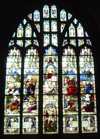 32.
Newbold Memorial Window 32.
Newbold Memorial Window
This window was installed in 1889, and dedicated to the memory of Henry Newbold
JP. In the two lights on the left is depicted Moses delivering the Law, and
on the right is Christ delivering the New Law - scripture quotations held by
angels make clear the connection between the two. In the middle is Christ seated
in judgement, with the Archangel Michael.
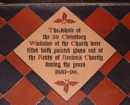 Tile
on the floor near Tile
on the floor near
the aisle crossing point
detailing the payment
for the clerestory windows |
Clerestory windows
Fifty windows glazed with hand-painted “stained glass of grisaille
type”. Like the Sarah Good window, they are by
Powell of Whitefriars, London, and are in a similar style. They were installed
between 1881 and 1890, the cost being met out of the rents from Brown’s
Charity.
| 


 Tile
on the floor near
Tile
on the floor near





















